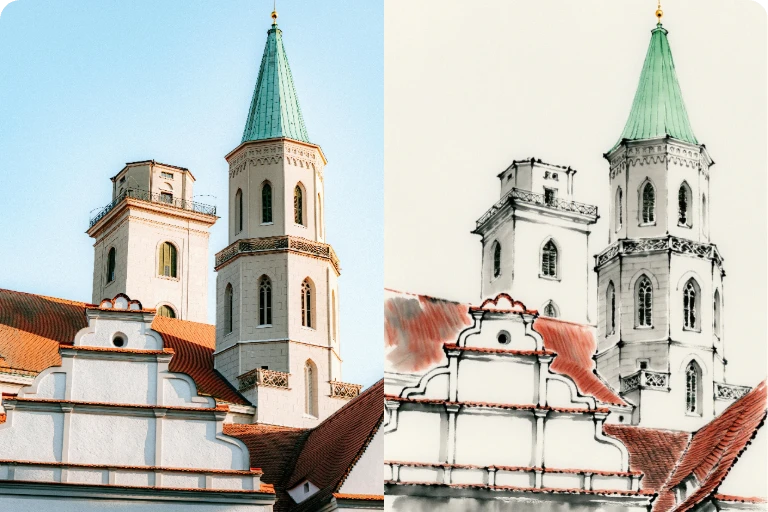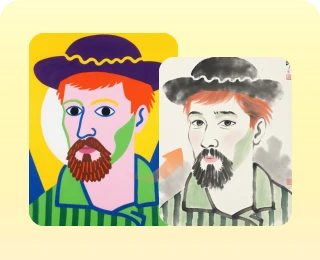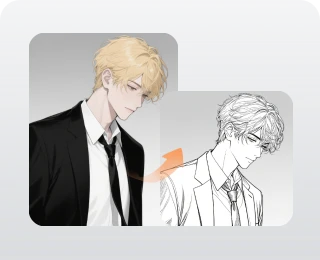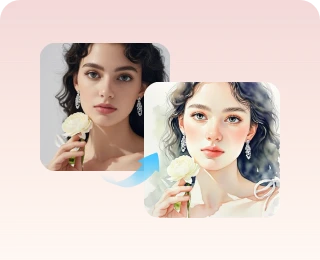AI has transformed creative artwork over the years, and AI drawing converters are one of the rapidly growing trends in digital art in 2025. These platforms can easily convert almost any simple photo into a hand-drawn sketch, and what once required hours with a pencil and a sketchbook can now be done in seconds with a few clicks. However, these converters differ from one another. Some provide real, beautiful sketches, some average but usable results, some are known for high-resolution (suitable for printing), and others focus on fast and shareable results for social media.
Hence, the questions: Which AI drawing converter should I trust with my photos? What defines a good converter? Are they even accessible to anyone, regardless of their skill levels? Rest assured, this guide has answers.

What Is an AI Drawing Converter?
An AI drawing converter is a platform that converts photos into sketches, illustrations, paintings, or hand-drawn images with the help of artificial intelligence. The AI algorithm uses the outline, shading, and texture of the photo to create realistic sketches.
Unlike basic photo filters, these converters generate results that often capture and preserve fine details, from facial expressions and textures to architectural lines and backgrounds. More so, they can be used for different purposes. Casual users try them for fun, social media enthusiasts use them for posts or profile pictures, pet owners turn their favourite photos into memorable portraits and keepsake sketches, designers and hobbyists use them for creative projects and commercial storyboards, and businesses use them for content branding and other purposes.
In short, AI drawing converters make it easy for anyone, regardless of skill level, to turn everyday photos into hand-drawn artwork.
How to Choose the Best AI Drawing Converter
With dozens of AI tools on the market, finding the right one for your needs can be a hassle. Therefore, knowing where to look and what to look out for is just as important.
Quality and Realism – The first thing to check is whether the converter retains the details (texture, facial features, and line depth) from the original photo.
Multiple Conversion Styles – A full range of conversion styles makes the tool useful to casual users, businesses, and professionals, all at the same time.
Ease of Use – Users with no prior drawing experience should go for converters with a simple interface and straightforward steps (i.e., upload, choose a style, and download).
Customization Options – Tools with adjustable and creative control over line thickness, contrast, shading, and other aspects are a prerequisite for professional use/users.
Pricing and Value – While free tools exist, premium options often give you a higher resolution output, no watermarks, and more styles. Inquire about the added benefits and decide if they are worthwhile.
Privacy and Safety – Good tools emphasize user privacy, data security, and remove the original material (photo) from the server once they are processed.
Top 5 AI Drawing Converters in 2025
As AI drawing converters became a trend, more tools have flooded the market. Nevertheless, here are the highlights of the top AI drawing converters, their strengths, and their uniqueness.
1. Fotor AI Sketch
Fotor has been a powerhouse in the photo editing space, and its AI sketch tool is one of its most popular features. It basically turns images into various styles such as pencil sketches, cartoon outlines, and watercolour-like drawings, among others.
Available on both desktop and mobile devices, it is a go-to for casual use and social media posts. But professionals and businesses might want to consider its paid subscriptions (Fotor Pro and Fotor Pro+) for much better results.
2. SketchTo.com
SketchTo.com is a professional-grade converter for users who require high-quality results. Its AI photo-to-sketch converter generates realistic, high-quality drawings that preserve facial elements and skin texture to an amazing degree. The platform does offer a free trial; however, the full potential of SketchTo lies within its premium version.
SketchTo is best suited for users who prefer accuracy and detail over speed of experimentation (i.e., designers, architects, and businesses).
3. ImgEdit.ai Photo to Sketch
ImgEdit.ai is one of the most reliable, user-friendly, and well-balanced tools available today. Its AI-powered converter can turn any photo into multiple sketch styles—from pencil to charcoal to ink outline to watercolour rendition—with just one click. The platform is designed for speed and simplicity, and the results are sharp, retain their natural look, and are available for download in HD. Privacy is another aspect in which ImgEdit excels. They delete uploaded photos from the server (system) shortly after processing them.
ImgEdit is also widely available and accessible. And the clean, streamlined interface means anyone can use it—it requires no digital or technical skills, and no learning curve. The results come out nice enough that you could print them as wall art or share them on social media platforms.
4. LightX AI Photo Editor
LightX takes a more creative angle than others. It mixes sketch conversion with other AI editing features. With LightX, you get the usual pencil and ink style; however, users can also blend sketches with diverse effects, add layers, or adjust tiny details. This setup makes it appealing to hobbyists, content creators, and artists.
While its sketch results may not be as realistic as those of ImgEdit or SketchTo, LightX is ideal for users who want creative freedom and versatility in one platform.
5. Anifun.ai
Anifun.ai provides one of the best free AI photo-to-sketch services available in the market. Thanks to its simple interface, it is relatively easier to upload a photo, choose a style, and even download a sketch in a matter of seconds. More so, Anifun does not add watermarks like other free platforms do, making it more appealing to casual users. Its output is not as polished; however, it is a surprisingly effective and reliable choice for users who want to explore AI sketches at no cost.

Head-to-Head Comparison of the Top AI Drawing Converters
Deciding on which of these converters to use often depends on what you value the most: realism, variety, creative options, or cost? All five tools can turn a photo into a sketch, but their results and overall experience vary. Here’s how they line up when matched to common needs.
For portraits and selfies, ImgEdit.ai and Fotor are the strongest contenders. ImgEdit.ai produces sketches that highlight fine details, from facial features to textures, with a natural, hand-drawn look. Fotor, on the other hand, offers more stylistic variety—allowing users to try different sketch filters for fun, each with a different level of realism.
For pets and personal keepsakes, ImgEdit clearly takes the lead. Its charcoal and pencil options handle textures like fur remarkably well, producing results that feel warm and authentic. Anifun.ai can also be used for this; however, the detail will be softer (noticeably lighter) in comparison.
For architecture and detailed linework, SketchTo.com is the top performer. Its professional-grade rendering captures sharp edges, shadows, and complex structures with precision. ImgEdit can handle simpler architectural shots, but SketchTo is better suited for high-resolution work intended for print or design presentations.
For creative experimentation, LightX stands apart. Its ability to blend sketches with other AI effects gives artists and hobbyists more freedom to customize results.
For budget-conscious users, Anifun.ai provides a straightforward, free solution. And for a free converter, it does not even add watermarks.

Privacy and Safety Concerns about AI Drawing Converters
Privacy is a natural concern whenever personal items are involved. And when it comes to AI drawing converters, the service providers are responsible for data security, as stated in their platform policy. Some platforms are transparent about how they manage your images after processing, but some leave users in the dark.
The best converters, however, prioritize data protection. For instance, ImgEdit.ai’s privacy policy mandates them to delete uploaded photos shortly after processing, reassuring users that their pictures are used only for the intended purpose (i.e., sketch conversion) and not for training databases or third-party sharing.
On the other hand, it is unsafe to use random (lesser-known) platforms. Some hold on to personal images longer than necessary, and some even watermark them and use them for adverts without consent. There are no risks involved in watermarking; however, these concerns place emphasis on the importance of reading and checking the privacy policy of each platform before you upload sensitive photos.
Therefore, avoid converters with no clear deletion policies and no established reputations, to be on the safer side.

Quick Guide: Making the Most of AI Drawing Converters
- Upload photos that are clear and have good lighting for better results.
- A face, pet, or object photographed closely is likely to produce a more realistic sketch.
- Experiment with styles – Tools like ImgEdit.ai’s Photo-to-Sketch have multiple sketch styles (e.g., pencil, charcoal, watercolour). Try them out.
- Download or save in high resolution if you have intentions of printing your sketch.
- Endeavour to check and read through the platform’s privacy policy before uploading personal or sensitive photos.
Takeaway
Since the advent of AI drawing converters, digital art has reached a milestone —so much progress that one can transform ordinary photos into masterpieces with just a few clicks.
More so, these tools have many uses, be it creating a personal keepsake, upgrading your social media profile, or adding a creative touch to business materials, and ImgEdit.ai is a good starting point in terms of quality, privacy, and ease of use.
